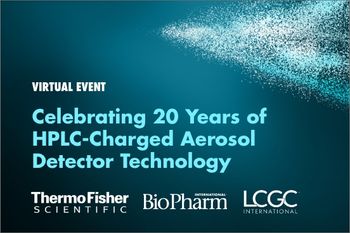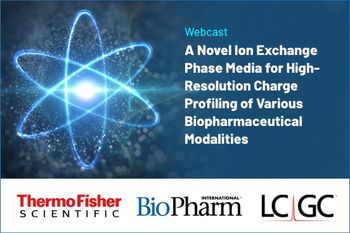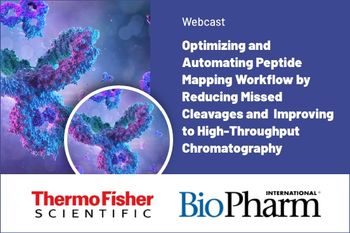Articles by Thermo Fisher Scientific

The first charged aerosol detector (CAD) was introduced in 2005. Nearly twenty years later, this
near-universal detector has become an indispensable tool in the analytical chemist’s quantitative arsenal.
This paper explores the CAD’s origin story, its adoption into everyday use by separation scientists, and its
comparison to evaporative light scattering detector (ELSD). Technical highlights will include how parameters
such as evaporation temperature influence application versatility, and how the power function impacts
linearity and response behavior.

Discover how automated plasmid purification can free up your lab's workflows and increase efficiency, scalability, and consistency without compromising quality. Get your copy of our eBook to explore real-world insights, actionable strategies, and innovative products you need to future-proof your pDNA purification processes.

Plasmid DNA purification has a vital role in molecular biology research. pDNA isolated at maxi scale is utilized in a variety of downstream applications, including mRNA synthesis, vaccine development, antibody production, cell and gene therapy and viral vector production. Learn about this new automated process.

Watch this webinar on how to improve your plasmid DNA research using automated and high-throughput extraction methods that are now available. High yield maxi prep can be hands free, and high-throughput pDNA midi prep is possible with magnetic bead-based technology.

Optimizing process productivity, improving scalability and increasing efficiency are all important steps to developing a biopharmaceutical manufacturing process and high-performance Chinese Hamster Ovary (CHO) media feeds, supplements and kits can help developers achieve these goals.

An interview with Dr. Evan Zynda – an expert in the cell therapy process development and manufacturing workflow – on some of the key areas of innovation within the cell therapy industry and where it’s headed in the future.

Cell therapy is set to transform the treatment of diseases across a diverse range of therapeutic areas. But, to meet these needs developers need to be ready to innovate and carve a path to success.

Preparing your cell culture process for scale up from the start can reduce the risk of delays, mitigate costs and rapidly deliver life-changing therapeutics to patients.

From automated processes and modular instrumentation to specialist regulatory support, discover how you can streamline your workflow and set the pace in cell therapy.

Webinar Date/Time: Wed, Jul 16, 2025 11:00 AM EDT

Automate your qPCR & dPCR workflows

Workflows to identify cancer biomarkers


Dr. Tim Sandle's SmartNote series discusses how a risk-based approach to environmental monitoring helps facilities maintain control over their environment and supports quality assurance efforts. Plus, they highlight the importance of selecting appropriate monitoring locations and taking proactive measures based on monitoring results to ensure consistent environmental quality and mitigate potential risks to product safety and integrity.

Learn about the typical state-of-the-art setup for high-throughput peptide mapping using chromatography and mass spectrometry (MS) techniques, as well as ways of simplifying mapping data.

Advancements in isothermal amplification technologies are fueling new diagnostic and clinical approaches for pathogen detection and cancer research.

Experience flexibility with TaqMan assays, offering over 2.8 million predesigned options to meet your specific needs.


An intelligent, on-premise platform connecting all the steps of your post-discovery routine qPCR workflows into one single ecosystem. Contact sales for a demo

Innovative qPCR tools for your bioanalysis and quality control. Fast-track your bioanalysis & QC with scalable innovative qPCR tools.

TaqMan SNP Genotyping Assays help you detect and distinguish single-nucleotide polymorphisms (SNPs) accurately and efficiently.

Multiplex better with the newest additions to the TaqMan portfolio

This note demonstrates identification of Infliximab charge variants from intact mass analysis enabled by two-dimensional liquid chromatography

Cell culture media is a foundational component of any biotherapeutic manufacturing workflow, crucial for maintaining cellular health and viability, maximizing titers, and supporting high product quality. As such, building a biotherapeutic manufacturing process with an optimized basal medium and feed system is vital to achieving optimal results and accelerating the speed-to-market of your product.
However, the process of finding the most suitable basal medium and supplementation
strategy can be challenging, as it requires balancing many key cell culture process
variables to achieve specific technical goals within budget and time constraints.
This guide will provide an insight into each development stage and offer best
practices to help you achieve your project goals on time and within budget.

Webinar Date/Time: Wednesday, August 9, 2023 at 5pm CEST | 11am EDT | 8am PDT

This customer note demonstrates the implementation of native SEC-MS using the Vanquish Duo UHPLC system.

With advances in the technologies used in LC-MS-based proteomics workflows, sensitive, reproducible, and efficient single-cell proteomics is now possible. Learn about these advances and how they work in concert to maximize the combination of protein and peptide identifications and sample throughput.

Webinar Dates/Times:
Thursday, June 29, 2023 at 17:00 CEST | 11:00 EDT | 08:00 PDT

This customer note will demonstrate the suitability of SEC for a fast and reproducible evaluation of adeno-associated virus (AAV) product titers

Discover how the Ramina Process Analyzer integrates with the 500L HyPerforma DynaDrive bioreactor to perform accurate in-line measurements and prediction models.







